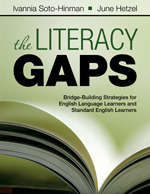The Literacy Gaps
Bridge-Building Strategies for English Language Learners and Standard English Learners
Bilingual/EAL Learners | English/Language Arts (Middle/High School) | Teaching Diverse Students
'The concepts of gaps and bridges are clearly articulated up front and provide a well-structured theme that unites the various parts of the text. The use of this structure provides a logical and coherent mechanism for providing a complete picture of the problem—the literacy gap between ELs and native speakers—and a means for addressing this problem'—Kristina Anstrom, Senior Research Scientist, The George Washington University Center for Equity and Excellence in Education
Build bridges of support so English language learners can learn alongside their peers!
English language learners (ELLs) and standard English learners (SELs) face multiple gaps as they strive to achieve, so educators need to take a holistic, comprehensive approach to bridge those gaps and meet the needs of ELLs and SELs in the classroom.
Based on an original, well-researched framework, this much-needed resource provides practical strategies for supporting learning and success for ELLs. The authors provide strategies, examples, and classroom tools to address:
- The gap between students and texts: covering word recognition, background knowledge, comprehension, and academic language development
- The gap between students and teachers: including socio-cultural differences between teachers and students, and teacher perceptions and expectations
- The gap between students and their peers: discussing language proficiency differences, grouping strategies, and grade-level and schoolwide programmes
The Literacy Gaps helps educators give ELLs the skills they need to close the most important gap of all: the achievement gap.
"The book makes a contribution to the education of English language learners. It provides practical instructional suggestions for teachers of both ELLs and SELs that are informed by a deep understanding of theories of second language and second dialect acquisition and the development of reading and writing proficiencies."
"The concepts of gaps and bridges are clearly articulated up front and provide a well-structured theme that unites the various parts of the text. The use of this structure provides a logical and coherent mechanism for providing a complete picture of the problem—the literacy gap between ELs and native speakers—and a means for addressing this problem."
"The strategies are clearly presented and there is just enough research cited to provide the rationale for incorporating ideas into instruction. Any teacher will find this book practical, and the discussions will provide meaningful ideas for study groups at the school site."
"This book presents content that is crucial for narrowing the achievement gap and powerful practical instructional strategies for increasing student achievement."
Text was highly detailed and clear
